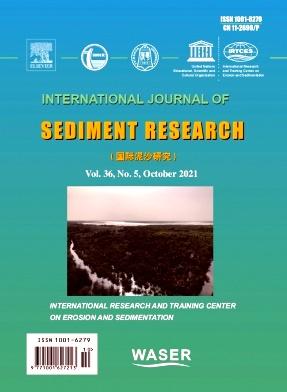城市集水区退化影响下的数据湿地泥沙沉积趋势推断
IF 3.5
2区 环境科学与生态学
Q2 ENVIRONMENTAL SCIENCES
引用次数: 0
摘要
湿地泥沙淤积导致保水能力下降,对这一重要淡水资源的生态构成严重威胁。这也增加了为这些湿地提供水源的河流集水区发生洪水的风险。沉积物主要是由上游集水区的无计划开发和丘陵切割产生的。因此,了解沉积物的沉积趋势对确定管理措施至关重要。然而,测量湿地的沉积物沉积是具有挑战性的。本研究通过地理空间技术探索了一种新颖且经济有效的方法来发现湿地沉积物沉积趋势,并比较了印度阿萨姆邦拉姆萨尔湿地Deepor Beel湿地的水范围。利用监督分类Landsat图像和归一化差池指数(NDPI)波段定量技术对水体扩展面积进行评估。本研究确立了泥沙淤积导致湿地水位上升,导致水体扩散面积增大。这通常表明淡水期水量在增加,表明河流湿地生态系统的健康状况较好。然而,这种明显的水量增加实际上是由于长期沉积在河床上的沉积物取代了水。该方法利用2003年和2021年具有可比降雨量的两年的地理空间水分布和海拔数据,确定了湿地的持水量在18年内减少到919万立方米。在没有最近和过去降水可比较年份的情况下,通过考虑两年之间净流入量的差异来调整表观量的增加,仍然可以应用所提出的方法。在考虑湿地泥沙截留率的情况下,由水土评估工具(SWAT)模型计算的泥沙向湿地输移的结果与所提出的方法非常一致。目前的方法可以扩展到类似的河流-湿地生态系统,以检查沉积物动态,并帮助为湿地和相关的流域保护和恢复制定更好的管理策略。本文章由计算机程序翻译,如有差异,请以英文原文为准。
Inferring sediment deposition trend in data scared wetland impacted by degraded urban catchment
The reduction in water retention capacity due to sedimentation in wetlands poses a serious threat to the ecology of this imperative freshwater resource. This also increases the risk of flooding in the river catchment areas that feed these wetlands. Sediments are mostly produced by unplanned development and hillcutting in upstream catchments. Henceforth, it is crucial to understand the trend in sediment deposition to determine management measures. However, measuring sediment deposition in wetlands is challenging. This study investigates a novel and cost-effective approach to discover trends in sediment deposition within wetlands via geospatial techniques and compares their water extents in the Deepor Beel Wetland, a Ramsar site in Assam, India. The water spread areas were assessed via supervised classified Landsat images and the band rationing technique, i.e., the normalized difference pond index (NDPI). This study establishes that sedimentation causes the water level in wetlands to rise, resulting in an increase in the area of water spread. This often suggests that the lean period water volume is increasing, indicating better health of the stream-wetland ecosystem. However, this apparent increase in water volume is actually due to the displacement of water by the sediment that has been deposited on the bed over time. This approach has identified a reduction in the water holding capacity of the wetland to 9.19 million m3 in 18 years by utilizing geospatially derived water spread and elevation data from two years (2003 and 2021) with comparable rainfall. In the absence of recent and past years with comparable precipitation, the proposed method can still be applied by adjusting the apparent increase in volume by considering the difference in the net inflow volume between the two years of interest. The results of sediment transport toward the wetland, as computed by the Soil and Water Assessment Tool (SWAT) model while accounting for the sediment retention rate of the wetland, strongly agree with the proposed approach. The present approach can be extended to similar stream-wetland ecosystems to examine sediment dynamics and help create better management strategies for wetlands and associated catchment conservation and restoration.
求助全文
通过发布文献求助,成功后即可免费获取论文全文。
去求助
来源期刊
CiteScore
6.90
自引率
5.60%
发文量
88
审稿时长
74 days
期刊介绍:
International Journal of Sediment Research, the Official Journal of The International Research and Training Center on Erosion and Sedimentation and The World Association for Sedimentation and Erosion Research, publishes scientific and technical papers on all aspects of erosion and sedimentation interpreted in its widest sense.
The subject matter is to include not only the mechanics of sediment transport and fluvial processes, but also what is related to geography, geomorphology, soil erosion, watershed management, sedimentology, environmental and ecological impacts of sedimentation, social and economical effects of sedimentation and its assessment, etc. Special attention is paid to engineering problems related to sedimentation and erosion.

 求助内容:
求助内容: 应助结果提醒方式:
应助结果提醒方式:


